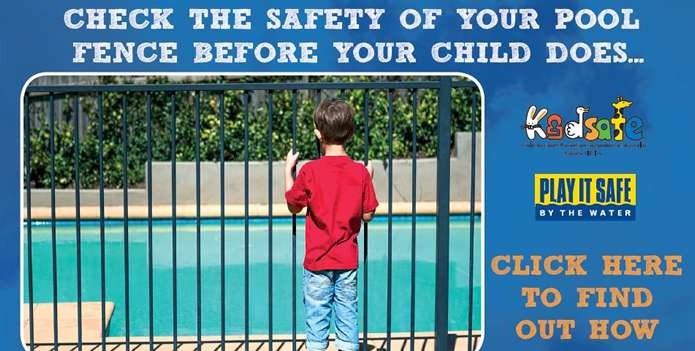Pool Safety

Kids love the water. But the question is, during summer, are they Water Ready? And more importantly, are you?
Young children can fall into a pool or spa and drown very quickly, so properly maintained safety barriers around pools are a vital measure to help secure the safety of the toddlers and children in your care.
It is law that protective safety barriers to restrict access to swimming pools and spas on private residential properties in Victoria. The responsibility for installation applies to all home-owners with a pool or spa, regardless of whether they have children living there or not.
If you have a pool or spa make sure barriers restrict toddlers from entering the pool area. When children are in the pool area, make sure there is constant adult supervision – not just the occasional glance. It the adult leaves the pool area, even for a short time, they should always take the child with them.
Once suitable compliant safety barriers have been installed, it is imperative that owners ensure the barriers are maintained so they continue to work properly - there is no point having a fence if children can climb it or if the gate has been left propped open.
Furthermore, remember a fence is no substitute for adequate supervision, and supervision means constant visual contact, not just the occasional glance while reading or talking.
Never take your eyes off children playing in or around the swimming pool or spa.
In order to be Water Ready remember:
- Supervision means constant visual contact - never take your eyes off a child
- Supervision means taking children from a swimming pool/spa with you if you leave the area, even if only for a moment
- Supervision includes ensuring that safety barriers such as gates and doors are not left open by children, in poor maintenance, or propped open
- Pool fences, fences, gates, doors and windows that form the barrier must be fitted and operating correctly
- Ensure the barrier area is maintained and landscaped so that children can't climb tree branches, pot plants, boxes, play equipment, clothes lines or any other nearby objects to gain access to the swimming pool/spa
- Consider inspecting adjoining properties to ensure there are no potential hazards or objects that may allow young children access to the swimming pool/spa
In summer, don’t risk increased fines or worse still, a tragedy at your own home. Make sure you and your pool are Water Ready and that your backyard is a safe and enjoyable place.
Download further information about pool and spa safety barriers.
Adult Supervision
The provision of suitable barriers to restrict access to a swimming pool/spa is no substitute for the adult supervision of children who are playing in or around the area of the allotment containing the swimming pool/spa.
The following is a number of simple steps to follow to ensure that young children are suitably supervised in and around the swimming pool/spa area:
- Supervision means constant visual contact and not just an occasional glance whilst inside a home, reading, snoozing etc
- Supervision means taking children from a swimming pool/spa with you if you are required to leave the area, if only for a moment
- Supervision includes ensuring that safety barriers such as gates and doors are not left open by children, in poor maintenance, or, propped open in a permanent manner
Maintenance
Once suitable safety barriers have been installed in compliance with Regulation 5.13 of the Building Regulations 1994 it is imperative that building owners ensure that an ongoing maintenance program is undertaken to ensure that the bafflers fulfil their intended purpose.
The following is a number of simple steps to follow to ensure that the safety barriers are appropriately maintained:
- Maintenance of safety bafflers installed to gates, doors and windows to ensure that they are still fitted correctly, and, still operating correctly
- Maintenance of fences to ensure that they are still in excellent condition and are non-climbable
- Maintenance of landscaping to ensure that tree branches, pot plants etc. are not able to be climbed by young children to gain access to the swimming pool/spa
- Maintenance of the general area surrounding safety barriers to ensure that chairs, boxes, ropes, pool pumps, clothes lines, dog kennels, children's play equipment etc. are not able to be climbed by young children to gain access to the swimming pool/spa
- Consideration should also be given to an inspection of adjoining properties to ensure that, over time, there has not developed potential hazards or climbable objects that may allow access by young children to the swimming pool/spa
Swimming pool fences and spa safety barriers
Under the Building Regulations 1994 all swimming pools and spas installed before April 1991 must be provided with suitable fences or barriers to prevent small children entering the pool area. The regulations:
- Regulate any remaining non-compliant pools after the former compliance date
- Require compulsory self-closers to gates and doors in barriers to pre-1991 pools and spas to take effect from 1/7/02
- Introduce obligations for maintenance and responsibility
- Require building permits for new pool fencing and new pools with a depth of water of more than 300mm
- Increase maximum court fines for non-compliance from $1000 to $5000
Further information about these regulations can be accessed below.
Other Safety Initiatives
There are a number of other safety initiatives that can be initiated by building owners to provide even greater protection for young children in and around the swimming pool/spa.
The following is a number of safety initiatives for you to consider:
- Ensure that all persons using the swimming pool/spa do so in a safe manner
- Consider the potential dangers of the combination of alcohol and water
- Display a clearly visible resuscitation chart in an area adjacent to the swimming pool/spa. Include a reference on the chart to the location of the nearest telephone in case of emergencies
- Consider undertaking an approved first aid/resuscitation course
- Consider having young children take swimming lessons to familiarise themselves with water, and, provide them with the necessary skills to cope should they get into difficulty in the water
- Development of a water safety plan in the event of an accident or emergency

